Learning Objectives
After this course participants will be able to:
- Describe the technology levels and gain of the Muse and Muse iQ Power Plus BTE.
- Describe what gain options are available for custom RIC receivers.
- Describe what style and technology level the Muse iQ RIC rechargeable is available.
Introducing Muse iQR
This course will give a big picture overview of the new products with this latest release. As we get into certain areas, I will direct you to other AudiologyOnline courses that will provide you even greater insight on programming and utilization of these products. We will also step back and review the iQ product launch that occurred in September of 2017, as these new products build upon what we've done over the course of the last 18 months. I will wrap up the presentation with an overview of our Synergy platform, and outline the features available on all of the products within the Acuity OS 2 operating system. Lastly, for the benefit of those who may be unfamiliar with our new product platform, we will also discuss some specifics of the iQ features themselves.
Rechargeable Reimagined
Let's say "hello" to rechargeable reimagined by viewing a brief introductory video.
As you can probably tell from that video, we are excited to be introducing Starkey's brand-new rechargeable product, the Muse iQ Rechargeable RIC device (Figure 1). This is Starkey's first foray into the lithium-ion rechargeable technology.
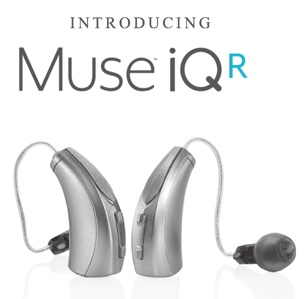
Figure 1. Muse iQR.
We do offer a full course on this device itself. Available on AudiologyOnline, the recorded course is titled "Rechargeable Reimagined" presented by my colleague, Dr. Andrea Hannan Dawkes. For the purposes of this presentation, I'm going to give you some of the highlights of this product. If you want to learn more details about this device, as well as obtain more information about rechargeable technology in the hearing aid industry, I would recommend viewing Dr. Dawkes' course.
With lithium-ion technology, the Muse iQ Rechargeable offers a 20% longer battery life than any other lithium-ion hearing aid in the market. Furthermore, our product is 30% smaller than any other rechargeable hearing aid on the market. It is also 100% easy to use.
Why Rechargeable?
There are a number of reasons that Starkey has decided this is the opportune time to introduce a lithium-ion device. One key factor in the decision to develop this product is that patients regularly ask about rechargeable technology. The patients that we work with today are familiar with and well-versed in charging devices, such as smart phones and tablets. Rechargeability in a hearing aid is high on their list of priorities. Another reason why the timing is right to introduce this device is that the rechargeable lithium-ion technology allows us to accommodate the daily power demands of patients, even with streaming. I've been in the audiology industry for 30 years now, and the concept of rechargeable technology is not new. There were rechargeable analog hearing aids 25 years ago. Although they were low power consumption devices, the rechargeable batteries could sometimes barely last an entire day. Today, we are working with high-performance digital technology, coupled with wireless capabilities. Now, we have the ability to accommodate all of that in a long-lasting hearing aid charge.
Increasingly, patients also are becoming more environmentally conscious. For some patients, the idea of throwing away hearing aid batteries every few days doesn't make sense, especially in light of all the rechargeable devices that they use on a daily basis. Rechargeable technology provides a sustainable solution, not only by keeping more disposable batteries out of landfills, but also by offering a recyclable option. Rechargeable batteries are cost-effective. There is an additional charge upfront with a rechargeable hearing aid system, as they are slightly more expensive than non-rechargeable hearing aids. In the long run, it's going to pay for itself in not having to purchase batteries on a regular basis. Finally, rechargeability lends to ease-of-use and convenience. Patients don't have to open up a battery door with this type of product. It's simply a matter of placing the hearing aids on a charger at the end of the day. Clearly, there are many reasons why now is the time to introduce a best-in-class lithium-ion rechargeable hearing aid solution for your patients.
Specifics of the Muse iQR
To reiterate, as of the date of this webinar, the Muse iQR is the smallest rechargeable hearing aid available today. It's an elegant, luxuriously designed device with a programmable rocker switch and uses our angled SnapFit Smart Receivers. It also offers the longest lasting usable charge of any device on the market today, delivering up to 30 hours of usability (including streaming) with a single charge. We'll get into some of the specifics of charge times and usability hours in a moment. With the Muse iQR, we wanted to emphasize what we refer to as "patient-focused," ease-of-use-features. For example, this hearing aid automatically turns off when you put it onto the charger, and automatically turns on when it is removed from the charger. There is no need to push any buttons to power them on or off when inserting or removing from the charger. Additionally, the Muse iQR is the first true rechargeable wireless CROS system available for patients with single-sided hearing loss. We will go into more detail about that aspect shortly.
Everything Your Patient Wants
As you can see, this system is highly flexible and will meet the needs of a vast majority of your patients that are interested in a rechargeable hearing aid. Of course, the rechargeability component, as well as the size, the look, and the feel of the hearing aid are important. However, above all, it is going to provide the best hearing possible for your patients. The Muse iQR is built upon everything that we've done over the course of the last 18 months with our Synergy platform, our Acuity OS 2 operating system, and our iQ features. The end result is the best hearing possible for your patients. Furthermore, the Muse iQR runs on our proprietary 900sync wireless platform, which means the patient has true total wireless connectivity, as well as full compatibility with any of our SurfLink patient accessories. The MuseiQR boasts the programmable rocker switch on the device for user controls. It uses the same angled SnapFit Smart Receivers we've been using for a number of years now. The Muse iQR also has a programmable telecoil for interaction with phones or looped environments. The Muse iQ Rechargeable is available in three technology levels: i1600, i2000 and i2400. These same technology levels are also available in all of the other iQ products.
Synergy Charger
Let's take a look at the charger and how the hearing aids interact with the charger itself (Figure 2). We call this our all-in-one charger. It plugs into a wall outlet, and the hearing aids are put into the charger at night. The charger itself also has an onboard battery. If the patient needs to go mobile with their charger, the onboard battery allows for up to three full charges of the hearing aids without being plugged into the wall. As long as that onboard battery is holding its charge, you're going to be able to charge the hearing aids, even without plugging the charger into the wall.
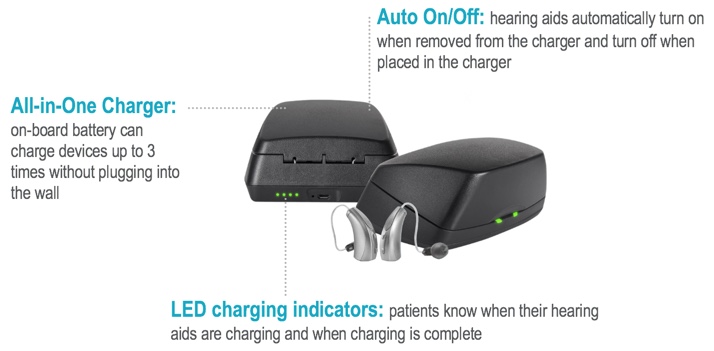
Figure 2. Synergy charger.
The charger itself has a couple different LED indicators. The LED indicators on the back of the charger display the amount of battery remaining in the onboard battery. The LED lights on the front of the charger indicate the charging status of the hearing aids. If these green LED lights are blinking, that means the hearing aids are currently in the charging process. Once the hearing aids are fully charged, those LED lights will remain on solid green. As ease-of-use is of key importance for your patients, the hearing aids will automatically power on when they are removed from the charger. They will also turn off automatically when placed into the charger. The patient doesn't have to push any buttons during that process.
If we take a look inside the charger itself (Figure 3), you can see the desiccant puck holder for dehumidification of the hearing aids. When the hearing aids are charging, you would close the case, and this dessicant puck will absorb any moisture. This puck was deliberately left exposed, because over time, as it becomes saturated with moisture, the crystals in the puck will change color as a visual indicator for the patient to obtain a new one. The lid of the charger is easy to open and close. However, when it is closed, it closes tightly, and will not open accidentally if the patient is carrying it in their purse or briefcase.
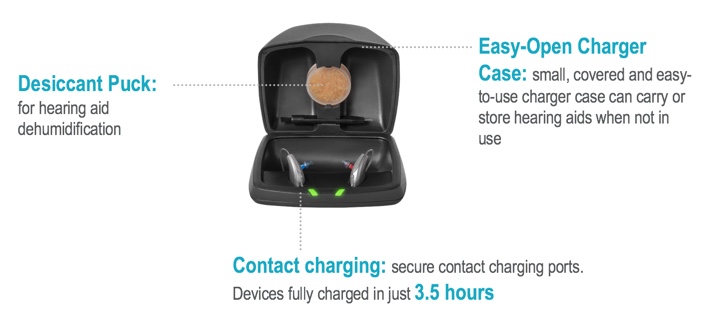
Figure 3. Inside the Synergy charger.
In terms of placing the hearing aids into the charger, there is a designated right and left slot for each hearing aid. When the hearing aids are placed correctly (which occurs easily due to a magnetic connection), the user can hear a distinct click. If the hearing aid batteries are completely dead, a full charge will only take three and a half hours.
Battery Life and Charge Times
A fully charged lithium-ion battery will provide 30 hours of use, which includes 80 minutes of streaming time/wireless connectivity using one of our wireless accessories (e.g., a media streamer, cellphone connectivity with a SurfLink Mini Mobile, a remote microphone, etc.). If you stream for 80 minutes a day, you'll get 30 hours of use time on the hearing aids with a full charge. Even if you increase the streaming time all the way up to five hours a day, the use charge on the hearing aids is still 26 hours. These times are based on a 50-gain receiver. We don't have the battery life estimates on the 60 or the 70 gain receivers. Obviously, it's not going to be quite as much as the 30 or 26 hours.
To achieve a full charge on the hearing aids, it takes about three and a half hours of charge time. If the patient charges the hearing aids for only two hours, they're going to still get 24 hours of use time out of the hearing aids. If they charge for only 30 minutes, they'll get four and a half hours of use. A quick 15-minute charge will allow for two and a half hours of use (Figure 4).

Figure 4. Charging times and battery life.
In a worst-case scenario, let's say a patient has forgotten to charge their hearing aids for a couple of days. They get to work, and realize their hearing aids are going to die soon, but they have a meeting in half an hour. That patient could take their hearing aids out, plug them into the charger for 15 minutes and they'd have two and a half hours of use. It is likely that most patients are going to charge these hearing aids exactly as they charge their cell phones: by plugging it in next to their bed or on their dresser every night. However, in cases where that does not occur, they can take advantage of the quick charge option in an emergency situation.
Fully Rechargeable Wireless CROS System
The Muse iQ Rechargeable is the only fully rechargeable wireless CROS system on the market. With our CROS system, the Muse iQR is available in the same three technology levels: the i1600, the i2000 and the i2400. We also have the Muse iQR Transmitter. If you're not familiar with our approach to CROS systems, you would first order the Muse iQR receiver for the better ear, in the technology level that you desire (e.g., i2400). You would then order the Muse iQR transmitter for the dead ear, or the side that needs the transmitter. For us, the transmitter is what we call "tier agnostic." In other words, in and of itself, the transmitter doesn't have a technology level assigned to it. When you program the transmitter and the receiver together during the fitting, the transmitter then takes on the technology level, features, and performance of the receiver that it has been coupled to. If you get a rechargeable transmitter, and you're using it with an i2400 receiver, the transmitter takes on the characteristics of that i2400 device. The advantage to this approach is that the transmitter is a lower-cost component than the hearing aid. You're not paying the cost of two high-level hearing aids; you're paying for whatever technology level that you're ordering for the receiver, and then the transmitter is the same cost regardless of technology level, because it simply takes on the characteristics of that receiver.
Additionally, you can fit the rechargeable CROS system in whichever modality is required for your patient. On a per-memory basis, you could program one memory to be a BiCROS, for instance, if they need a BiCROS mode. You could have a different memory as a CROS modality. You could have a different memory as a hearing aid-only memory if you desired. Also, you can mix and match any of these three modalities any way you choose within the same system, based upon the needs of the patient. Of course, with a wireless CROS system, the transmitter and receiver are continuously communicating with each other via that 900sync wireless platform. The wireless/streaming component is working almost 100% of the time the patient is wearing the system. This is going to stress the life of that rechargeable battery to its maximum capacity. With the wireless CROS rechargeable system, we would predict the battery life to be 15 hours. Is that the same as the non-CROS system? No. But it should get your CROS patients through a full day of use.
The other thing about our CROS systems is that the directionality, the noise control features, etc., act completely independent on the transmitter and the receiver side. If the listening environment dictates it, the transmitter and the receiver could be functioning differently from a directionality perspective, or from a noise control perspective. Or, if the environment dictates it, they can be working exactly the same. It's independent of performance when it comes to both directional microphones and noise control.
We also have what we call our balance control. This allows you, within the programming software, to set where the main signal is coming from (i.e., the transmitter side, the receiver side, or have them be equal). You also have the ability to give the patient control over this balance control. By using the onboard rocker switches, they can shift where the main input is coming from. Do they want more coming from the transmitter? Do they want to hear more from the receiver side? Or do they want it to be equal? You can set that up in the user control configuration to give them the ability to mix the sound coming from the transmitter and the receiver for best hearing, depending on the situation that they're in.
Comes with Everything You Need
When you order the Muse iQR Rechargeable system, you get everything in one package. When it's delivered to your office, you will, of course, receive the hearing aids, which are shipped inside the charger itself. You get a set of right and left receivers of the gain level that you have indicated on your order. You will have the option to visually mark the hearing aids with right and left indicators (red and blue). You get the HearClear wax protectors for the receivers, as well as the desiccant puck. You will also receive a carrying pouch, if the patient wants to transport their hearing aids without putting them in the charger. In addition, you will get a cleaning tool, and an operations manual for the hearing aid and the charger. You will be sent the USB-to-micro USB charging cable, as well as what's known as the Wall Wort (the part that plugs into your wall outlet that you plug the USB cable into). All of this comes with the brand-new Muse iQR lithium-ion rechargeable system.
ZPower: Rechargeable Silver-Zinc Batteries
In addition to our new lithium-ion Muse iQR, we also have our silver-zinc ZPower solution. There are many reasons patients may select the lithium-ion option, however there may be reasons why a patient doesn't choose that type of battery. Starkey Hearing Technologies offers two rechargeable solutions for ultimate flexibility in meeting the needs of patients and professionals.
When it comes to other rechargeable options, our ZPower Muse and Muse iQ micro RIC 312 have been available since 2017. This is another option if your patients are looking for a rechargeable solution, but are concerned about not being able to use a standard hearing aid battery. There are patients that, due to their lifestyle and how they interact with their hearing aids, may be concerned that they wouldn't be able to get their hearing aids charged as often as they would like to. They may travel a lot, or perhaps they go camping for extended periods of time where they couldn't conveniently plug in their hearing aid. That's where the ZPower would be a fantastic solution for them, as the ZPower uses what's known as a silver zinc rechargeable cell. The advantage of a silver zinc cell is that it can be taken out by the patient and replaced with a standard zinc-air battery, if needed. You can offer them the same advantages of rechargeability, as well as the convenience of being able to swap the silver zinc rechargeable cells with zinc-air batteries.
One difference between the silver zinc versus the lithium-ion option is that the silver zinc batteries do need to be replaced approximately once a year. After about 12 months of use, the rechargeable silver zinc cell will start to lose its ability to hold a full charge. This is going to be your opportunity to bring the patient back into the office at least once a year to replace those rechargeable cells. They can only get them from you; they can't order them online. At that time, you can counsel the patient, and perhaps do a cleaning and check their hearing. The ZPower is another option that you can offer to patients that are looking for a rechargeable option, but maybe have slightly different needs.
Lastly, in spring of 2018 we will be introducing our first rechargeable made for iPhone hearing aids. The Halo iQ and Halo 2 RIC 312 will be able to use our ZPower rechargeable solution. This will provide another option for your patients that are using made for iPhone devices, or for those who are looking for the latest made for iPhone hearing aid, as well as for a rechargeable solution. It's a nice-looking device with a well-integrated battery door to plug into the ZPower charger.
Muse iQ Power Plus BTE 13
Our other exciting new product launch is the Muse iQ Power Plus BTE 13 (Figure 5). When I was fitting hearing aids every day as a clinical audiologist years ago, when I needed power, I always thought about Starkey, whether it was for BTEs or custom products. Starkey did power better than anyone else. We're incredibly excited to be bringing our Power Plus BTE into the current product line with the Muse iQ Power Plus BTE 13.
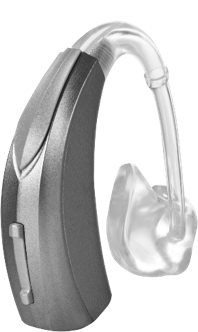
Figure 5. Muse iQ Power Plus BTE 13.
This particular device is a 140/80 matrix. We are looking at a Power Plus device, maximum power. It has the patient-preferred programmable rocker switch. It is also CROS compatible. You've got a Power Plus BTE that now also has CROS compatibility. Of course, integrated telecoil for telephone use and looped environments. It also runs on our 900 MHz wireless platform. It is available to use with all of our SurfLink accessories. With a size 13 battery and the 140/80 matrix, we are seeing a 7-10-day battery life, which is fantastic for these patients that are squeezing every bit of power out of their hearing aids that they possibly can. The Power Plus BTE is available in both the Muse iQ technology family and the Muse technology family. The Muse iQ is offered with three technology tiers: the i1600, the i2000 and the i2400. The Muse is available in five tiers: the i1000, the i1200, the i1600, the i2000 and the i2400.
The Muse iQ Power Plus BTE is our most durable hearing aid made to date. It has an IP rating of 68. Power users can be tough on their hearing aids. They wear their hearing aids every moment of the day, sometimes even during the night. Having this IP 68 rating means that you can be confident you're offering the most durable hearing aid possible.
Programming Muse iQ Power Plus BTE
When you program the Muse iQ Power Plus BTE, we would recommend that you select "Prefers Power Fit" in that initial fit protocol (Figure 6). That's going to make sure that we're providing the maximum gain that the patient needs, based upon their audiogram.
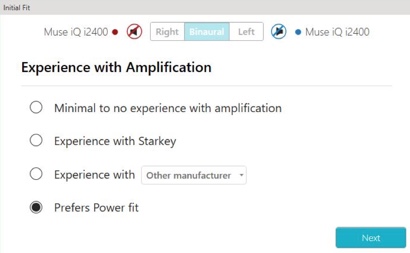
Figure 6. Initial fit protocol.
You'll also notice in the fitting screens this pinkish warning banner up above the MPO curves (Figure 7). This is indicating to you that this is a high output device, that it could reach MPOs of higher than 132dB. It's a warning to you to remind you this is a superpower BTE.
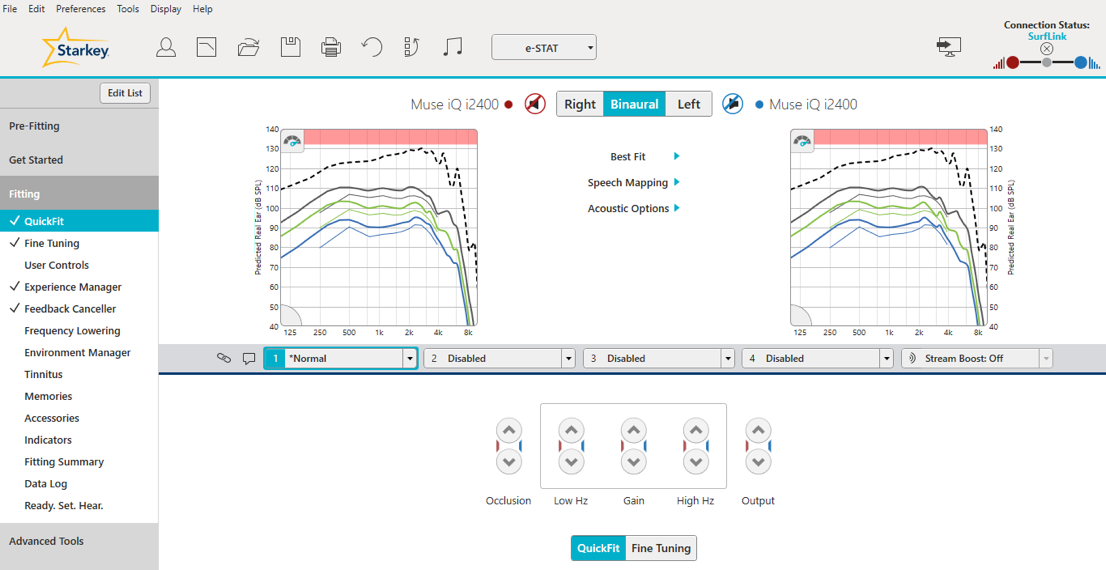
Figure 7. Warning banner for high output device.
With the iQ products, it will automatically initialize Acuity Boost (Figure 8). This guarantees that we're squeezing every bit of power out of this device and maximizing the MPO. The patients that you're fitting with these types of hearing aids, they want to squeeze every bit of gain and every bit of output of their hearing aids. That's what this Acuity Boost feature is going to give them.
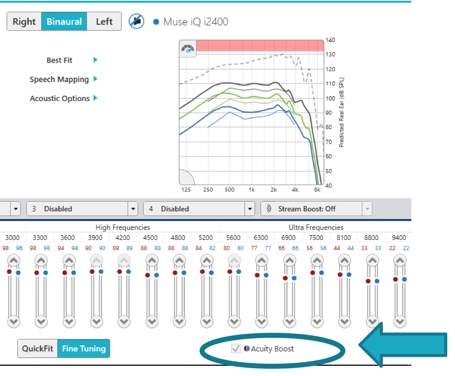
Figure 8. Acuity Boost.
If you want to see everything that is new with Inspire 2018, our programming software, AudiologyOnline has a recorded course available titled "Inspire 2018".
A Power Solution for Everyone
From BTE to CIC, Starkey offers the most comprehensive lineup of high gain instruments in the market. We are excited to have the Power Plus BTE. It's a fantastic addition to our product line. The other thing to remember is we are the only hearing aid manufacturer that has a full earmold lab in house. We can couple the power of that BTE with an earmold that's appropriate in terms of style, material and comfort. We have the right styles, we have the right materials, in terms of softness and strength and sealability in that ear canal, and we've got our full earmold catalog available to you online at starkeypro.com. You can also access that through the Inspire programming software.
RIC Power Solutions
Of course, we can provide power with our receiver in the canal devices as well (Figure 9). We offer the 50 and 60dB gain stock receivers. We do have a power ear bud or power dome if you need to use that. We have custom molds for our stock receivers. We also have our custom AP or Absolute Power receivers. These are custom-built lucite receivers with the receiver embedded in the earpiece itself. You can get this in the 50, 60 or 70dB gain receiver levels. The 70dB is only available in the custom AP receivers.
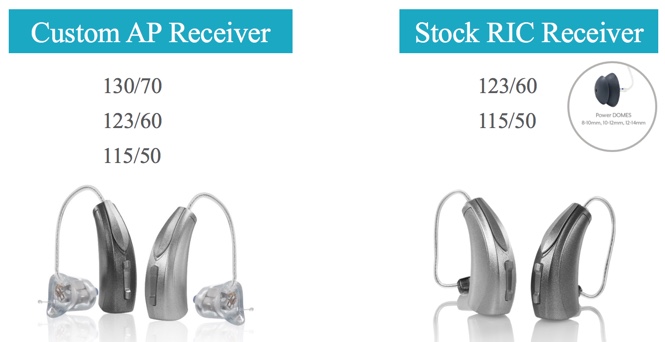
Figure 9. Custom AP and Stock RIC receivers.
Custom Power Solutions
When it comes to custom, we can provide up to 70dB gain all the way down into our CIC devices (Figure 10). Here in the US and worldwide, the use of custom hearing aids has dropped off significantly in the last decade or so. On average, I'd say 25% to 30% of the fittings in the US are custom hearing aids. Although they have decreased in popularity, that's still a lot of people and a lot of patients that want the option of a custom hearing aid instead of a BTE or a RIC style hearing aid. We can fit almost any hearing loss in a custom style, again including 70dB gain, all the way down to a CIC. Don't neglect your patients that want custom hearing aids, even if they require high gain devices.

Figure 10. Custom power solutions.
All of our custom devices, the Power Plus BTE, and the new rechargeable Muse iQ RIC device run on our proprietary 900 sync wireless platform. In other words, they're all fully connected using our SurfLink wireless accessories.
Synergy Platform
We are very pleased with the Muse iQR Rechargeable system, and we're excited about the upcoming Halo iQ ZPower devices. Additionally, now you have at your disposal the Power Plus BTE 13 in both the Muse and the Muse iQ, including CROS compatibility with these new products. Truly, what has brought us to this point is our Synergy platform. Synergy is the computer chipset that runs all of these technologies. We started with our Acuity OS operating system about a year and a half ago, that was improved upon last year with our second-generation Acuity OS 2 and the introduction of the iQ features in the fall of 2017.
What I want to do now is take one step back and remind you of what does the iQ mean in the iQ product families. What is it that sets the iQ devices apart? We're talking about three different technologies: the Muse iQ, the SoundLens Synergy iQ and the Halo iQ families (Figure 11).

Figure 11. iQ product families.
All of these, including the new products that I've just mentioned running on Acuity OS 2, have the three technology levels and incorporate all of the best-in-class features, like our twin compression for music enhancement, frequency lowering, feedback cancellation, wireless platforms, and noise management. In addition, iQ brings three unique features to the technology available to your patients with these iQ devices: Acuity Immersion with e-STAT AI, Acuity Immersion Directionality and Acuity Quiet. Two of these are hearing aid-style specific. I'm going to break that down and talk about what's unique about each one of these technologies and each one of these features.
Acuity Immersion with e-STAT AI
Acuity Immersion with e-STAT AI is specific to approaching this idea of what's known as spatial hearing. Dr. Simon Carlile, our Vice President of Research, is one of the world's leading experts in binaural processing and spatial hearing. He has specifically examined what role the outer ear plays in spatial hearing. What does your pinna, concha and torso do to present a unique sound quality to the eardrum? Every single ear is different: the way sound hits the eardrum is completely different for each person, because of the shape of their ears. Particularly, in the ultrahigh frequencies, you get a lot of variation in the spatial cues that the patient perceives.
The way the sound hits the eardrums in a typical ear, all of the spatial cues are between 4,000 and 10,000 Hz, where a lot of unique peaks and valleys occur. Of course, that's where a hearing loss hits first and foremost. Not only does a person lose the ability to hear and understand speech well, they lose their spatial cues very quickly with the hearing loss. With the Muse iQ CICs and the SoundLens IIC devices, Acuity Immersion is used to redistribute the spatial cues between 4,000 and 10,000 Hz and down into a frequency range that the patient can hear better, providing a unique amount of gain for these spatial cues, without negatively affecting speech understanding. We're going to make sure they not only hear speech as best as they possibly can, but we will also enhance that hearing with spatial information. Over time, the brain relearns what the spatial information means and restores their sense of three-dimensional hearing in a listening environment. You can only do this with the natural pinna cues of the patient's own ears, by using a CIC and an IIC with that microphone placed down into the ear canal.
Acuity Immersion Directionality
Acuity Immersion Directionality attempts to restore some of this natural high-frequency emphasis that the pinna and the concha create, but using a BTE or a RIC device. As audiologists, we know that as sound enters the ear canal, this creates an ear canal resonance that essentially emphasizes high frequencies, provides a boost of high frequencies of about three to four dB. If you put the microphone above the ear, you eliminate that because the sound is now going into the microphone there, and not in the ear canal (Figure 12).
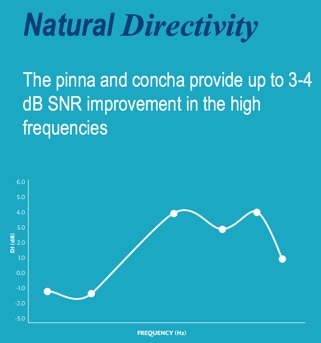

Figure 12. Natural directivity vs. standard hearing aids.
With Immersion Directionality, we are taking that microphone response and creating an omni mode in the lower frequencies, and a fixed directional mode in the high frequencies to restore this high-frequency emphasis (Figure 13). Any time a RIC or a BTE detects an omni mode type of environment (e.g., the noise isn't high, signal-to-noise ratio is decent), the hearing aids will no longer be in an omni mode. They'll actually be half omni and half fixed directional. As soon as the patient changes locations to somewhere noisy (e.g., the signal-to-noise ratio gets poor, input levels get high), we'll switch into our channel-independent adaptive directionality. The goal of Acuity Immersion Directionality is to replicate or restore some of the natural high-frequency emphasis when you're using a BTE or a RIC, in what would have in the past been an omni directional mode.
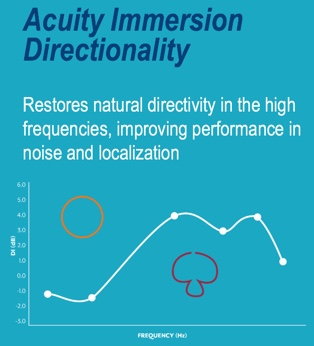
Figure 13. Acuity Immersion Directionality.
Acuity Quiet
The last iQ feature to discuss is what refer to as Acuity Quiet. This is available in all styles, ranging from the IIC all the way up through the new power BTE Muse iQ Power Plus. We've coupled expansion technology with our patented fast-acting noise management tool. Up until this point, every hearing aid manufacturer has used expansion in one form or another to try and reduce circuit noise and reduce the effects of low-level noise inputs in quiet environments. Starkey has coupled that channel-independent expansion technology with channel-independent, fast-acting noise management to guarantee the hearing aids are as quiet as they possibly can be in quiet listening situations. We conducted a study with this technology where we had patients listen to the hearing aids in a completely quiet environment with expansion alone and with Acuity Quiet on. In the end, 94% of the people in the study stated that the hearing aids were noticeably quieter with the new Acuity Quiet technology.
As you can see, Starkey has built upon the Synergy platform, the Acuity OS 2 operating system, and our iQ features. Now, for those patients who need that maximum power and output, we are offering the Muse iQ RIC rechargeable lithium-ion technology and the Muse iQ Power Plus BTE 13. With the addition of these two most recent product lines, the iQ family of products continues to expand to provide more fitting flexibility and options for any patient.
Summary and Conclusion
Starkey is an evidence-based company. We research, verify and validate everything that we do. Sometimes, however, it is helpful to hear what fellow professionals and patients have to say about our products. These are some quotes from the professionals that have been fitting these hearing aids, and patients that have been wearing them.
Our professionals have commented:
- “My patients are absolutely amazed with the extended bandwidth and improved music clarity.”
- “Another fantastic Muse iQ fitting! I feel like the REAL test of how a hearing aid performs is seeing how a patient does from their initial fit to their two week recheck."
- “My first patient said, ‘Don’t make any adjustments, it sounds like I used to hear. Even my own voice sounds natural!'”
- “Starkey technology truly is a personal touch with a personal outcome.”
Some of our patients have made the following statements:
- “The hearing aids become much more valuable to me as the weeks progressed.”
- “In all cases, I was able to hear like normal without distractions by the devices.”
- “These hearing aids gave me more confidence in my ability to hear conversations going on around me.”
This type of information speaks for itself. With the Synergy platform, Acuity OS 2 operating system, iQ products, Muse iQR and the Muse iQ Power Plus BTE, Starkey is striving for patient-driven solutions. Hopefully, throughout the course of this session, we piqued your interest in not only the new products, but also what we're doing with the full iQ product line. Again, if you want more details on rechargeable technology, take a look at that course, "Rechargeable Reimagined". That course provides not only the information I presented today, but also more specific programming details, information about how the patients will use the hearing aids on a daily basis, and our demonstration of the brand-new Inspire 2018 programming software.
Citation
Camacho, L. (2018, May). The right power, performance and personalized solution for any situation! AudiologyOnline, Article 22506. Retrieved from www.audiologyonline.com


